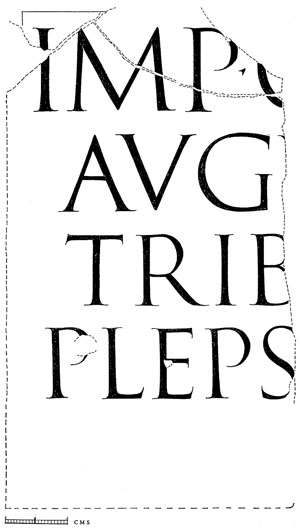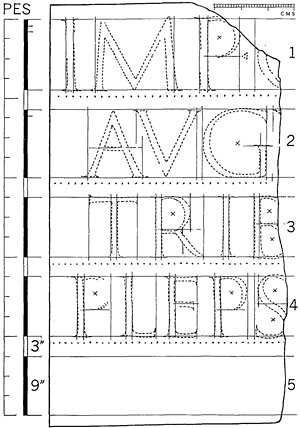
Processes in the Making of Latin InscriptionsInscriptions speak of the processes employed in their making. It is not difficult to distinguish the great quantity of informal, roughly-chiselled lettering from that which has been regulated within an ordered plan, accurately constructed and carved. My studies in the measurement and making of Latin inscriptions (PBSR Vol. LXX 2002) have been drawn from this comparatively small number of regulated works. The first and second centuries AD provide the majority of examples of scriptura monumentalis, the disciplined style of incised capital now linked inextricably with Trajan through the lettering on his column (CIL VI. 960). However, examples of meticulous construction found in the first century BC suggest that a regulated system of letter design, probably Greek in origin, was established some two hundred years before Trajan. Admittedly the early constructed letters were rigid, angular, lacking the fiuency of the brush-painted outlines that followed. A substantial corpus of measured drawings is needed if any useful conclusions are to be drawn about a regulated system of lettering and design. One fine example from the inscriptions studied so far must serve to demonstrate the sequence adopted for all studies. Fragments of CIL VI. 40310=36896=3747 (fig. 1) from the portico of the Basilica Romanum, are dated to 2 BC. The lettering is fully developed scriptura monumentalis and of the highest quality in its construction and execution. My half-scale drawing has been assembled from digital images taken through a 10mm line grid. Measurements from the stone are combined with the digital images to determine the value of the pes found to be a respectable 297mm. The pes division of the lettered field is shown in fig. 2. One interlinear space of three inches has been distributed between lines 1 and 2, an indication of ordinatio, the organising or regulating process; the space below line 4, another foot of depth capable of accommodating one line height and one line space, suggests a fifth line of text. 
Fig. 1: CIL VI. 40310. Fragments drawn by R.D. Grasby The unit has been deduced from the width of the vertical stem, which has the ratio 1:10, one unit wide to ten high. Many inscriptions in bolder lettering use the ratio of 1:8. Fig. 2 shows clearly the coincidence of the vertical stems and the sides of proportional rectangles with the 'ruler' in units for each line set out below the letters. Fig. 3 brings together in diagrammatic form information obtained from analysis of the fragments of CIL VI. 40310 and measurement of the letters. 
Fig. 2: CIL VI. 40310. Measurement of fragments and constructed letters The sequence followed for this and all other studies starts with an evaluation of the pes for the inscription and its application to the fragments (fig. 2). Letters of the restored text and missing letters are given unit values of width including serifs, and are bunched together without letter spaces (fig. 3). Thus, the square brackets marked AA in line 1 define the minimum space in which it is possible to contain the letters in each line. Space units are not distributed using the fragments as the guide to the generosity or otherwise of letter-spacing. Space units in many inscriptions appear to have been used to equalise line lengths rather than to achieve a pleasing visual effect. Frequently there is no unit of space between letters, serifs collide and two letters share one serif. It is important to state that I applied space units to the text of CIL VI. 40310 before giving consideration to the possible overall dimensions of the inscription. 
Fig. 3: Unit values applied to restored text from CIL VI. 40310. Line lengths are proposed and the shaded margins marked BC in line 1 applied to the right-hand end of each line. Line indentation is not necessarily an indication of a centred layout. However, there is evidence for a central position of this inscription on the portico of the Basilica and lines 2 and 3 have the appearance of careful ordering to achieve a centred layout. On the basis of the two near-equal line lengths 2 and 3, a lettered field suggests itself, 5' high by 12'6" long, a rectangle composed of two squares and a half-square. When the verticle D is introduced to indicate a right-hand border, letter spacing brings line 2 to within one unit of the proposed border, and line 3 to within three units; even these slight disparities could be resolved by adding one unit for each medial point and, so, equalising the line lengths. CIL VI. 40310, with the analysis contained in fig. 3, may now be offered for an epigraphic review of the text before making a drawn reconstruction of the complete inscription. CIL VI. 36896 restores the title DIVI IVLI F; if this is more probable, then line 1 may be comfortably spaced to the same length as lines 2 and 3. Constructed capitals in the style scriptura monumentalis, found in a variety of inscriptions and from every province of the Roman Empire, reveal a remarkable consistency of proportion and letter outline. It is now possible to predict the forms of those letters which are missing from the fragments but are necessary to a reconstruction. These predictions can be more firmly based on unit values, proportions and minimal structural geometry. My first concern is for the letters themselves. I seek to identify the tasks facing the ordinator in setting out the lines of the 'blue print' over which the brush-letterer painted the final forms to be cut in V-section by the carver. I have made comparative studies of letter forms from each inscription to reveal shared characteristics. Finally reconstruction of a complete inscription from its fragmentary evidence is essential in order to reveal the underlying design; the square grid can be identified behind the arrangement of letters, their disposition on the stone and as an instrument for the regulation of draft text. While there can be no certainties, the recurrence of these grid 'patterns' within inscriptions cannot be easily dismissed. I use digital photography and computer imaging wherever possible. However, creating full-size images of inscriptions, many over two metres long, and examining large letters, is most easily achieved by traditional methods such as rubbings and tracings, leading to drawings on stable film. Today these traditional methods supported by multiple digital images, give an unparalleled opportunity to study lettering in its finest detail away from the site of the inscription. I would welcome discussion with others working in this field, where the restoration of text might be usefully combined with a measured survey of an inscription and analysis of its lettering. Studies of inscriptions completed: measured surveys, reconstructed drawings and letters of: RIB 12, 288, 330; CIL VI. 941, 1823, 24064, 36908, 37077; CIL X. 1063; CIL XII 3261; CIL XIV 83, 86. Studies of inscriptions in progress: digital photographic surveys, measurement and some drawings of letters of: CIL VI. 27959, 31689, 31778, 40210; CIL XIV. 4707; ILS 9505; AE 1952,165; AE 1979, 399 Richard Grasby Home | What's New | Events | Images | Links |
| Created on |